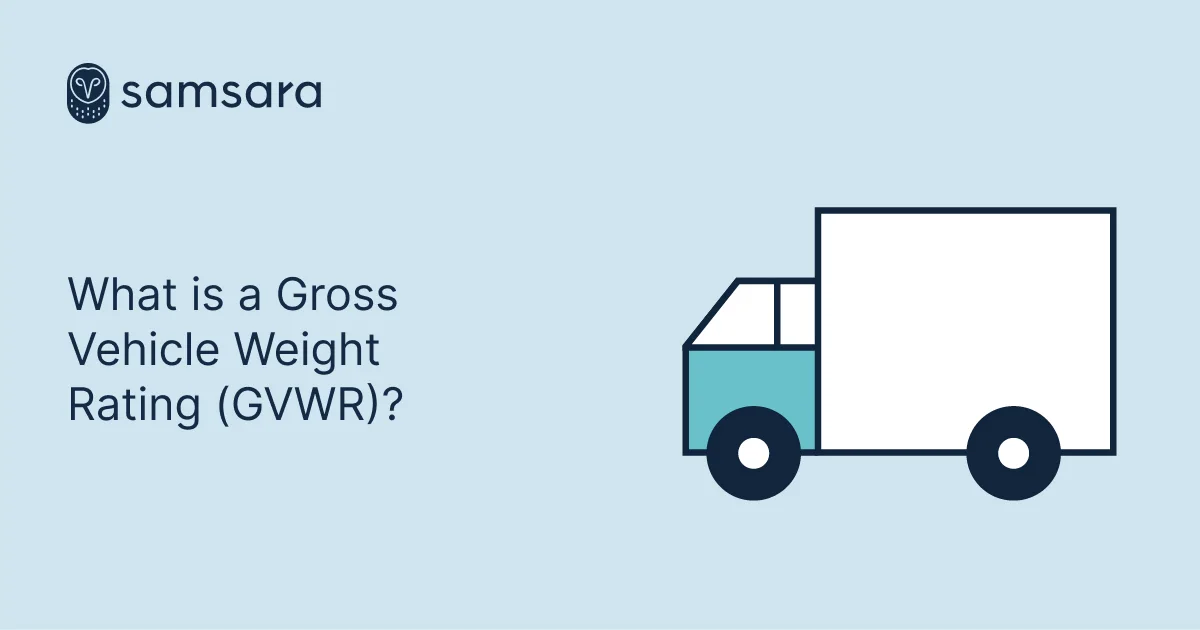What is a Gross Vehicle Weight Rating (GVWR)?
October 22, 2021

Get Started With Samsara
Check Our PricesKey Takeaways
Understanding and knowing a vehicle’s gross vehicle weight rating (GVWR) is important because it helps maintain safety. When drivers don’t know what the GVWR is, it could lead to overloading their vehicles. This can damage a vehicle’s suspension and lead to costly repairs. Learn more about GVWRs.
What is a gross vehicle weight rating (GVWR)?
The gross vehicle weight rating is the maximum operating weight of a vehicle as specified by the manufacturer. It is also known as gross vehicle mass.
The difference between GVWR, GCWR, and related terms
While GVWR is the maximum loaded weight of a single vehicle (or trailer), the gross combined weight rating (GCWR) is the maximum weight of the vehicle with a trailer attached. “Combined weight” is the total weight of both the tow vehicle and the trailer together. It also includes any cargo or load in either vehicle.
When understanding GVWR and GCWR, it’s important to understand these related terminologies:
Gross axle weight rating (GAWR): The maximum amount of weight on each of the axles.
Gross trailer weight (GTW): The actual weight of a fully-loaded trailer.
Tongue weight: The total weight at the trailer hitch.
Curb weight: Total weight of an empty vehicle.
Dry weight: Total weight of a vehicle without fluids such as fuel, oil, coolant, water, and brake fluid.
Payload: The total weight of any cargo and passengers.
Where to find your vehicle’s GVWR?
Fleet managers can find a vehicle’s gross vehicle weight rating on a sticker inside the driver’s side door. The sticker should list both the curb weight and the GVWR. If the information isn’t there, you can find it in the owner’s manual.
How is GVWR determined?
The GVWR tells truckers the amount of weight their commercial vehicle can handle safely. This figure includes the curb weight and payload capacity.
Curb weight is what a vehicle weighs when empty of passengers or materials—essentially what it weighs when it’s resting on the curb, not in use.
Payload capacity weight is the add-on weight drivers can safely add to a vehicle’s curb weight. Payload includes the weight of passengers, accessories, fuel, and “tongue weight.” Tongue weight is the static force the trailer tongue exerts on the hitch ball of a tow trailer. This is normally 10-20% of the combined tow load and trailer weight.
Why is GVWR important?
The gross vehicle weight rating is a measure of safety. When a vehicle manufacturer rates a vehicle for its maximum weight, they consider its suspension, frame, axles, wheels, and other load-bearing components.
If drivers don’t know what the GVWR is, they might overload their vehicles. Overloading a vehicle can damage its suspension and lead to costly repairs or downtime. Also, if a vehicle is pulled over while over its GVWR, the driver could be fined. Consequences are more severe if an overloaded vehicle gets into an accident.
A vehicle’s GVWR also impacts legal requirements. For example, vehicles above a certain GVWR need additional insurance or require the driver to have a commercial driver’s license (CDL).